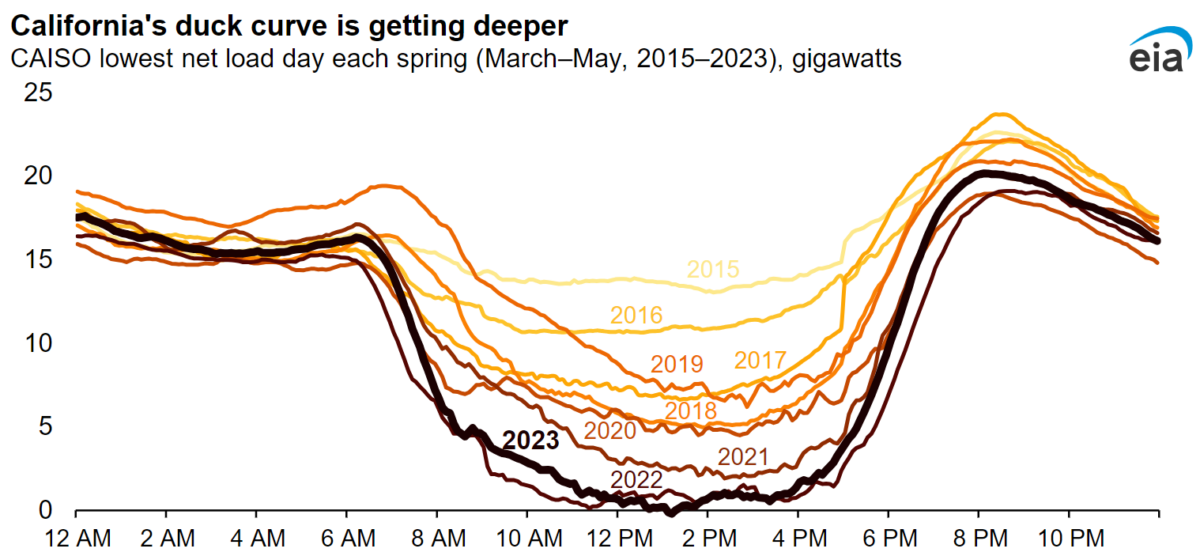From pv magazine USA
The phenomenon of the “duck curve” is an electric grid operation concept that signifies the mismatch between peak solar generation (midday to afternoon) and peak electricity demand (late afternoon and evenings). Shaped like the outline of a duck, the curve shows the peaks and valleys of this mismatch throughout a typical day.
The experience of a duck curve can cause stress on the grid and challenges for the electricity market, causing California and other solar-friendly states to boost adoption of energy storage to meet these challenges.
The Energy Information Administration (EIA) shared that as solar adoption grows in California, the “duck curve” is deepening. The midday dip in net load is getting lower, making it more difficult for the California Independent System Operator (CAISO) to balance the grid.
The swing in demand for electricity from conventional power plants from midday to late evenings, when energy demand is still high but solar generation has dropped off, means that conventional power plants like natural gas-fired peaker plants must rapidly ramp up electricity production to meet demand. That rapid ramp up makes it more difficult for grid operators to match grid supply with grid demand in real time, a mechanism that balances the grid both physically and in the wholesale marketplace.
Additionally, if more solar power is produced than can be used, operators may have to curtail, or deliberately shut off, solar assets to avoid over generation. The California Independent System Operator (CAISO) curtailed 1.5 million MWh of utility-scale solar in 2020, representing 5% of total production, according to EIA. Solar is by far the most dominant source of energy that undergoes curtailment in the state. EIA said 94% of power curtailments in 2020 involved solar energy.
Curtailments reach a peak in the spring months, where demand is relatively low and solar output is relatively high. For example, in the early afternoon hours of March 2021, an average of 15% of utility-scale solar was curtailed, CAISO data showed as reported by the Energy Department.
EIA also warned that the duck curve scenario also challenges traditional, dispatchable energy sources by making it uneconomical to operate them around the clock. This harm to a given facility’s revenue may lead to a retirement of the facility without a highly dispatchable replacement, the EIA said.
“Less dispatchable electricity makes it harder for grid managers to balance electricity supply and demand in a system with wide swings in net demand,” said the EIA.
However, the duck curve has opened the door for energy storage to meet the grid-balancing needs of California and other renewables-based economies.
“The large-scale deployment of energy storage systems, such as batteries, allow some solar energy generated during the day to be stored and saved for later, after the sun sets,” said the EIA. “Storing some midday solar generation flattens the duck’s curve, and dispatching the stored solar generation in the evening shortens the duck’s neck.”
Battery energy storage in California has quickly grown from 200 MW in 2018 to nearly 5 GW today. Operators plan another 4.5 GW of storage capacity in the state by the end of the year according to EIA data, suggesting the solar-plus-battery boom has only just begun.
Despite its higher total project costs, solar-plus-storage has an advantage in capture price, said global risk assurance firm DNV. Plants with storage can charge their batteries when sunlight is plentiful during the day and sell the stored electricity when the price is high. DNV said that by 2038, the capture price advantage of solar and storage co-located projects will surpass the cost disadvantage, making these projects even more attractive.
“PV and storage systems are designed as a ‘package’ that can produce energy on demand, just like hydropower, nuclear, or combustion power plants,” said DNV.
In 10 years, DNV said roughly 20% of solar projects worldwide will be built with dedicated storage, and by mid-century such projects will reach about 50%.
This content is protected by copyright and may not be reused. If you want to cooperate with us and would like to reuse some of our content, please contact: editors@pv-magazine.com.




2 comments
By submitting this form you agree to pv magazine using your data for the purposes of publishing your comment.
Your personal data will only be disclosed or otherwise transmitted to third parties for the purposes of spam filtering or if this is necessary for technical maintenance of the website. Any other transfer to third parties will not take place unless this is justified on the basis of applicable data protection regulations or if pv magazine is legally obliged to do so.
You may revoke this consent at any time with effect for the future, in which case your personal data will be deleted immediately. Otherwise, your data will be deleted if pv magazine has processed your request or the purpose of data storage is fulfilled.
Further information on data privacy can be found in our Data Protection Policy.